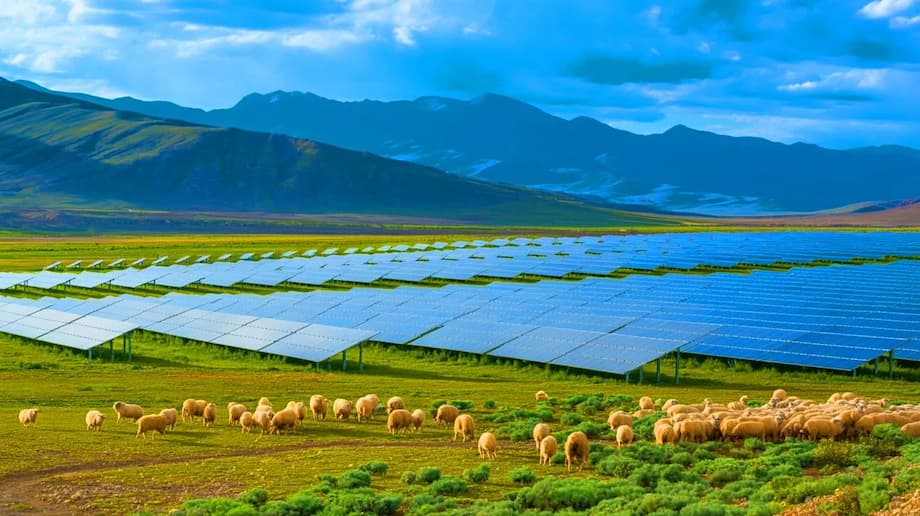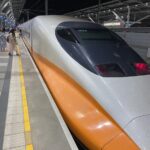A new oasis shaped by solar panels
Across the high plains of Qinghai on the Tibetan Plateau, China has built a sprawling solar project that is changing both the energy mix and the land beneath it. On about 235 square miles of desert terrain, more than seven million photovoltaic panels feed electricity to the grid on clear days and cast shade on the parched ground for the rest of the time. That shade, paired with calmer winds between panel rows, is helping grasses and small shrubs take root in places where bare soil and sand once dominated. Herders now guide sheep through the array, using the renewed vegetation as forage while helping keep plant height in check.
This is the world’s largest contiguous photovoltaic complex, and its footprint is large enough to supply power for up to five million households when conditions are favorable. The project sits at the junction of two urgent priorities: cutting carbon emissions and stabilizing landscapes that have been creeping toward desert conditions for decades. China contains vast desert and semi-desert zones, and national studies estimate that roughly a quarter of the country’s land is desert. Desertification pressures have affected hundreds of millions of people through dust storms, erosion, and the loss of productive land. A mega project in this setting tests how energy infrastructure can double as a landscape management tool.
Early evidence points to a measurable ecological lift where panels are installed, while scientists also caution that careful design and management are needed to avoid new pressures on fragile land. Research teams who evaluated the Gonghe Photovoltaic Park, the core of this Qinghai buildout, report shifts in moisture, temperature, and wind at ground level that support vegetation recovery. They also find changes in soil nutrients and plant diversity that call for ongoing monitoring. The picture that emerges is not a miracle greening, but a steady, managed nudge toward healthier ground conditions alongside very large clean energy output.
How a giant took shape in Qinghai
The heart of the project lies in Gonghe County within Hainan Tibetan Autonomous Prefecture, straddling the Talatan Gobi Desert. The site receives intense solar radiation for much of the year, yet suffers from low precipitation and high evaporation. Engineers deployed rows of monocrystalline and polycrystalline silicon modules on both fixed-tilt and single axis tracking structures, arranged to capture long hours of sun while creating shaded corridors where winds slow and humidity lasts a bit longer near the surface.
Where it is and how it works
The plateau’s high elevation, cold winters, and dry air set strict limits on vegetation. At Gonghe, long-term climate data show average annual temperatures near 4 degrees Celsius, with relatively scant rainfall and very high evaporation. Sunshine duration can range from roughly 2,300 to 3,500 hours per year. Inside the solar field, the panels interrupt direct radiation and lessen the force of near-surface winds. That microclimate effect is small at the scale of a single panel, yet across hundreds of square miles it creates a patchwork of calmer, cooler daytime ground conditions that reduce moisture loss. The result is more favorable conditions for seeds to germinate and for shallow-root plants to persist.
Power for millions and a steadier grid
The combined capacity serves as a major contributor to regional power, especially during peak daylight hours. Operators report supply for up to five million households, a figure that depends on seasonal sunlight and grid dispatch. Local officials and industry analysts say the project has anchored jobs in construction, operations, and maintenance, while the scale of new generating capacity has helped keep power prices more stable in surrounding communities and increased energy security for western China. Qinghai has become a showcase for clean energy integration, pairing solar with transmission links that feed demand centers and with land management practices inside and around the array.
What changes under and around the panels
Panels change surface conditions in three basic ways. They block a portion of incoming solar radiation from hitting the ground. They slow the wind where rows act like low windbreaks. They redirect rain and snow into narrow strips along panel edges. Together, these changes support higher soil moisture near the surface, gentler temperature swings at ground level, and reduced scouring by wind. In a desert setting, even modest changes in moisture and wind exposure can give grasses and hardy shrubs a better chance to take hold.
Microclimate and soil
Peer reviewed studies that focused on the Gonghe site provide structured evidence for these shifts. A 2024 analysis used a DPSIR based framework, a method that tracks drivers, pressures, state, impacts, and responses to assess environmental change, to compare conditions inside the solar park with surrounding control zones. The on site area returned a composite ecological score of about 0.44 on a scale where higher values indicate healthier conditions, while transitional and off site areas scored near 0.29. Researchers linked the better on site results to small but consistent improvements in microclimate, soil moisture, and microbial communities. The study’s indicator system, which combined field sampling, remote monitoring, and statistical weighting, points to an overall trend of improved ground conditions inside the array compared with nearby land without panels. Readers can explore the methodology and findings in the Scientific Reports article hosted by Nature at this link.
Field records in other arid solar parks on the plateau show similar microclimate patterns. Soils beneath arrays tend to run cooler during the day and slightly warmer at night than exposed ground, with relative humidity levels shifting in ways that reduce stress on new seedlings. Less wind at the surface, especially during the windiest seasons, also cuts sand movement around young plants. These conditions do not guarantee robust plant communities, but they lower the barriers to germination and survival when combined with basic land care.
Vegetation and nutrients
Plant communities, however, respond in complex ways. Research in the Qinghai desert found that while biomass under panels rose, species richness and the Shannon diversity index fell compared with control plots outside the array. Soil water content increased under panels, while available phosphorus dropped. Analyses identified soil water and available phosphorus as key variables shaping which species dominate. That mix of results suggests managers should track soil nutrients and plant competition as vegetation returns. Options include targeted seeding of native species in inter row zones, small-scale phosphorus supplementation in depleted patches where native plants are phosphorus limited, and seasonal timing of maintenance work to protect regrowth.
Are deserts seeing a net ecological gain?
A separate study of solar development on the Qinghai Tibet Plateau used ecosystem service models to evaluate carbon sequestration, sand fixation, and soil retention from 2011 through 2020 across pre construction, construction, and post construction phases. After the arrays went in, modeled carbon sequestration increased by about 71 percent, sand fixation by about 81 percent, and soil retention by about 32 percent. The strongest improvements clustered within roughly 400 to 500 meters of the installations, a distance that reflects how microclimate and surface roughness effects tend to fade with space. The full article, published in Environmental Research Letters, is available from IOP at this link.
These metrics matter because they translate on-the-ground changes into services that landscapes provide to people. Carbon sequestration reflects how much carbon plants and soils can store, which helps with climate mitigation. Sand fixation tracks the stability of the surface, an indicator that relates to dust storms and erosion. Soil retention captures the capacity of the ground to hold onto topsoil during wind and rare rainfall events. Gains in these services, if maintained, mean fewer dust days, better conditions for grazing, and a more resilient base for surrounding ecosystems.
Researchers also stress that not every indicator moved in a positive direction. In some assessments, fungal abundance and daily photosynthetic radiation under panels scored lower, which suggests that changes in light and competition can stress some organisms even as biomass rises. That is why monitoring and adaptive management are central to the project’s ecological goals. Scientists recommend buffer zone management near array edges, compact but ecologically sensitive layouts, and routine ecological surveys to adjust practices as the site matures.
Sheep, land care, and operations
Grazing has returned to parts of the park, where herds move through panel rows to feed on new grasses and low shrubs. Provincial programs present this as a blend of renewable power, vegetation cultivation, and animal husbandry that supports both land recovery and rural incomes. Reports from Qinghai describe significant vegetation regrowth in areas once considered barren and note that herders have gained new income sources by integrating grazing with solar site management. Sheep help recycle nutrients through manure and keep vegetation heights manageable, which can reduce fire risk and limit shading on lower panel edges.
Grazing still needs a plan. Overgrazing can undo gains, especially in late summer when plants are vulnerable. Site managers typically rotate herds through designated blocks, rest heavily used patches, and restrict access after seeding to allow roots to settle. Fences around sensitive habitats, such as gullies that gather runoff from panel edges, reduce trampling. The most successful programs set stocking rates to seasonal productivity, then revise those rates based on vegetation surveys.
Dust control and cleaning routines are another daily reality in desert solar parks. Blowing dust can cut output and abrade glass. Vegetation inside the array, stabilized surfaces under panel rows, and gravel or crushed rock in high traffic lanes can reduce dust generation. Cleaning strategies range from dry brushes and air jets to light water rinses during periods when dust loads are highest. Because water is scarce, responsible operators set schedules that prioritize peak soiling seasons and invest in recovery systems where feasible. Small changes to site grading also help, directing runoff away from footings and cable trenches to prevent scouring.
Planning matters on a fragile plateau
The Qinghai Tibet Plateau offers some of the world’s richest solar resources, yet its ecosystems are sensitive to disturbance. Spatial planning studies that merge land suitability analysis with ecosystem service valuation show why siting matters. When analysts mapped the plateau, they identified zones with the best balance of solar resource, terrain, access, and ecological resilience. Their maps suggest that a sizable share of the plateau has technical potential, but only a smaller subset rates as highly suitable once ecosystem services and land protections are included. Researchers have also found a mismatch between where projects have been built and where the best overall siting opportunities lie, a gap that careful planning can narrow.
China-wide siting research echoes those findings. A recent model that weighed solar resource, wind and sand hazards, and ecological factors concluded that gravel deserts tend to be more suitable than sandy deserts for very large projects. The analysis estimated that using a modest fraction of desert land could meet national electricity demand, while the most suitable clusters are concentrated in parts of the Qaidam Basin and the country’s north. The same studies stress that protected zones and areas with higher vegetation cover should be excluded, and that project density should be scaled to local environmental limits. The point is clear: smart siting reduces conflicts with wildlife and land users while improving long term project performance.
Planners and regulators in Qinghai have already adopted elements of this approach. Recommendations from recent ecological assessments include buffer zones near array edges, compact layouts that shorten disturbed corridors, targeted ecological monitoring, and adaptive regulation that can tighten or relax requirements based on measured site conditions. Those measures are increasingly standard for new projects and can be retrofitted to existing ones during repowering or maintenance cycles.
Jobs, incomes, and local buy-in
Construction of a site this size mobilized a regional workforce. Thousands of positions emerged during peak build seasons, followed by permanent roles in operations, vegetation management, and grid support. Local service businesses, from transport to accommodation, benefited during the buildout. As operations settled in, a second wave of jobs grew around land care and grazing cooperatives inside the array, giving herders a new way to blend traditional livelihoods with a modern energy project.
Officials in Qinghai promote a broader ecology-first strategy. Conservation work at nearby lakes and grasslands, training programs that hire residents as rangers, and UNESCO recognition for geologic sites have lifted local incomes through ecotourism and conservation jobs. The solar project fits that pattern by aligning energy investment with land restoration and rural development. That alignment matters for public acceptance. When communities see vegetation returning, dust lessening, and household incomes rising, they are more likely to support energy projects, report problems early, and take part in monitoring programs that keep the land healthy.
Energy security is another benefit often cited by regional planners. Western China’s vast solar and wind resources, including sites like Gonghe, now feed provincial demand and send surplus power eastward along high voltage lines. The scale of clean generation in Qinghai has improved daily and seasonal balancing when paired with flexible resources elsewhere on the grid. That reliability dividend is key for industries that operate on tight schedules and for households that want stable bills.
What expansion could look like elsewhere
The lessons from Qinghai are increasingly relevant to other arid regions. Design choices that lift ecological performance are practical and replicable. These include spacing rows to limit scouring winds, directing runoff to vegetated strips, choosing compact access roads to cut disturbed area, and adding buffer belts along array edges. Managers can seed native plants in inter row areas, time maintenance around growing seasons, and coordinate grazing to match seasonal productivity.
Studies also point to clear spatial patterns. The strongest boosts to ecosystem services often occur within a few hundred meters of the installations, which implies that benefits concentrate in and near the array footprint. That pattern should guide where to invest in monitoring and where to place protective buffers for wildlife movement. Planners should pair any large project with a site specific ecological baseline, then use a DPSIR based indicator set to measure progress and adjust practices. Public reporting of those metrics can build trust and sharpen decisions on whether to expand, pause, or modify a project.
None of this guarantees ecological success. Desert ecosystems vary widely, and even within a single province, soil chemistry, groundwater depth, and wind regimes can change over short distances. The Qinghai experience shows that large solar parks can support vegetation recovery and make the land more stable, while also revealing trade offs in plant diversity and soil nutrients that require attention. With thoughtful planning, transparent monitoring, and community participation, the balance can favor both power generation and land health.
Key Points
- China’s Qinghai project covers about 235 square miles with more than seven million solar panels that can supply power for up to five million households.
- Shade from panels and reduced wind between rows have helped grasses and shrubs return in parts of the Talatan Desert, supporting sheep grazing and soil stability.
- A 2024 Scientific Reports study using a DPSIR based indicator system found the on site area inside the Gonghe solar park scored better on ecological health than surrounding land.
- An Environmental Research Letters study reported post construction gains in carbon sequestration, sand fixation, and soil retention, with the largest gains within 400 to 500 meters of arrays.
- Vegetation biomass increased under panels, while species richness fell and available phosphorus declined, underscoring the need for nutrient monitoring and adaptive management.
- Site managers use grazing rotations, dust control, careful grading, and targeted seeding to maintain vegetation and reduce soiling on panels.
- Spatial planning research shows that gravel deserts often suit very large projects better than sandy deserts, and that smart siting avoids protected and high vegetation areas.
- The project has delivered jobs and steadier local power supply, while provincial programs link solar development with conservation and rural income growth.
- Key practices for replication include buffer zones, compact layouts, DPSIR based monitoring, and community engagement to keep ecological gains on track.




